|
By now you’ve probably read or heard many times that yoga can help skaters with issues they have to tackle:
performance anxiety breath control distractions negative self-talk improper goal setting unconstructive training environments and more… Plus, there are other “fitness” based areas that yoga can help skaters improve–balance, strength, flexibility, proprioceptive awareness, etc. Yoga is not enough to fix all our problems, but it can help us see them in a new light and learn to stand steady and undisturbed while facing them. It can help us turn a journey based on comparison into a journey of self-actualization.
0 Comments
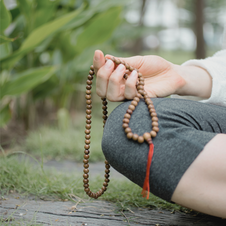 A skater practices mantra meditation using mala beads as part of their mental training routine. A skater practices mantra meditation using mala beads as part of their mental training routine. Mantra repetition, a powerful form of meditation, might be the missing link in your mental training. A mantra is a word, statement, or sound recited repeatedly out loud or silently to aid in concentration or to help redirect focus to a desirable outcome. Mantra meditation helps us become aligned with our goals. In Sanskrit, “man” means mind, and “tra” means vehicle. Just as Warrior II is a vehicle for practicing asana (physical postures), a mantra is a vehicle for developing the sixth limb dharana, or concentration. For this reason, sometimes mantras are called the “asana of the mind”. The first recorded use of mantras was over 3000 years ago. Today, they are widely used in nearly all religions (repeated prayers) and in many secular spaces throughout the world. The lead character of my favorite movie “French Kiss” is petrified of flying–has full-blown panic attacks–but she dreams of going to Paris with the love of her life. In the opening scene, she goes through a very expensive “U Can Fly” simulation. As she becomes increasingly agitated, the facilitator says over the loudspeaker “Kate, don’t forget your mantra”. Even in 1995 when this movie was released, the idea of using a mantra to help change subconscious thoughts and battle anxiety was part of popular culture. The vibrations of the sounds, the repetition, and the spirit behind the meaning all contribute to the many benefits of mantra repetition: Studies show mantra meditation can help lower anxiety and improve overall mental health, improve awareness, lower blood pressure, and potentially lessen intrusive thoughts and improve symptoms of PTSD. Life is full of distractions and new, shiny objects that call for our attention and focus. Especially in our modern society which moves faster and faster every day, our brains are conditioned now to seek new thrills, however fleeting they may be. The latest headline, notification, text, or cute cat on our feed, or the next bite of chocolate or sip of Starbucks… all give us little bitty hits of dopamine. The more we lean into these external stimuli for satisfaction, though, the more we are left craving more and more, and the more unsatisfied we become. This is not to say that Starbucks, Hershey’s, Apple, Samsung, Meta, YouTube, and TikTok are inherently bad and that we should never consume them. However, we need to practice enough moderation and separation from such distractions to offer ourselves space to discover our own intuition. The greatest need of our time is to clean out the enormous mass of Cobra pose is one of the most well-known poses of yoga, but if you need to improve your carriage in skating, you should practice Sphinx pose (salamba bhujangasana) instead.
Carriage is the term used to refer to how a skater carries their upper body–everything from the angle of the torso in relation to the lower body, the shape and placement of the shoulders, the alignment of the head and neck, and the length and look of the arms and hands. Carriage is what makes a skater’s performance look elegant, effortless, and polished vs. labored, choppy, and sloppy. 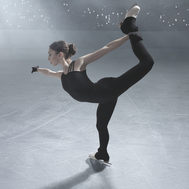 Figure Skater Executing a Spiral Variation Figure Skater Executing a Spiral Variation In last week’s blog I discussed the need for direction in our skating and explained why the common practice of setting SMART goals often doesn’t work for skaters. Without direction, we feel like we are skating in circles, getting nothing accomplished, even while working very hard. It is very frustrating! I’m from Kentucky, so I like to compare it to a thoroughbred–you can be the fastest horse in the world, but if you aren’t trained to run around the track, you can’t run the race. But SMART goals, by far the most common type of goal-setting used, can be harmful for skaters, who are often already highly focused and obsessive, and who thrive on the external validation of achievement. In my experience, the black and white nature of SMART goals creates a lot of anxiety in our already anxious modern beings. If you haven’t read that post, you can find it here. Instead of setting SMART goals, I encourage skaters to set intentions. By definition, an intention is a plan to think and act in a certain way, preferably in alignment with a greater principle or purpose. It involves staying focused and mindful in the present moment, rather than on the future or the past. Since an intention focuses on the present, it comes from the idea that we are already whole because we are all of a divine nature. The idea is that our intended action or thought is already within us… our purpose is to practice bringing it to light simply by getting to work. As always, the practice IS the path. What is a Good Intention for Skaters?In yoga, an intention is also called a Sankalpa, which can also be translated as a resolve or a vow to be upheld above all others.
This doesn’t mean that we forget all our other obligations and become single-minded to the point of obsessiveness (remember–we are trying to leave behind the obsessiveness of SMART goals). It means that we will be resolved to have one mindset or one purpose for each practice or period of practice–whether that period is a season, a month, a week, a day, or an hour. If you really have one quality you want to cultivate in your life, maybe your intention is one word for a season at a time. An example of this is how I choose a word of the year instead of choosing a list of resolutions–abundance, love, courage, flexibility, etc. Then I try to make sure my thoughts, choices, and actions are in alignment with this word. If you practice for many hours a day, you may have one purpose for each session. It can be a word–maybe you choose one of the yamas–or a positive statement or affirmation, such as “I use my breath to stay calm when I run into traffic during my program,” or “I am aware of my self-talk.” You can even make a positive statement about an element you really want to develop–i.e. I easily execute 9 revolutions on a forward camel spin. On your first session, you can focus on program run-throughs and all that entails, and on the next session, you focus on exercises for the camel spin. 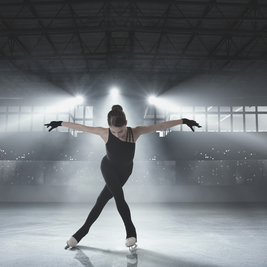 Female Figure Skater in an Opening Pose Female Figure Skater in an Opening Pose For the past several years I have really struggled with focus. I was miserable–my brain darting between tasks, unable to focus on any one thing for more than a few seconds at a time. During the act of teaching things felt fine–it’s naturally faster paced–but sitting to work at a computer for my other job, for writing, or for planning was challenging in a way it never had been. Even though I rarely eat processed foods, aim to get enough sleep, practice meditation, exercise, and drink enough water, I just… couldn’t. be. efficient. I knew something was off, but I still felt like a failure. Then, I read somewhere that “systems will beat hard work and talent every time”. And I realized that I wasn’t failing, but I certainly was spinning my wheels. I think it’s safe to say that, in 2023, the vast majority of humans struggle with focus. It’s impossible to process information as quickly as technology throws it at us. We can’t keep up with our obligations because our brains simply haven’t evolved as quickly as society demands them to. Add in processed foods, lack of sleep, the chaos of the world, and the frenetic pace of achievement we are compelled to follow, and our brains are in crisis. I needed a system and tools to help me dedicate time to do the work that really mattered most – like writing these blogs for the skating world – and to block out distractions. So, I went to work finding tools to help streamline my processes and started practicing their implementation, and I plugged in breaks throughout my day to allow my brain to reset in between tasks. This process has reminded me so much of skating. We’ve all seen skaters spin their wheels on the ice–they get so bogged down with what needs to be done that they move from one thing to the next with no focused effort to make any improvement. Or even worse, they fail to do anything because deciding where to begin is too difficult! In getting to work, it’s all about using your energy in the right way - Brahmacharya. (A few weeks ago I wrote about the yamas - a code of conduct presented to us in the 8 limbs of yoga… Brahmacharya is one of the yamas. You can read more about it here.) Coaches know this, parents know this, and deep down, skaters know it, too. But for it to click and to get a system in place can be very challenging. Enter the SMART goal. 3/18/2023 1 Comment Failing a Figure Skating Test Yogi Tea reminds us to celebrate both our successes and failures Yogi Tea reminds us to celebrate both our successes and failures I wish I had failed more as a skater. Of course, I experienced minor failures every day in practice as I worked to achieve new skills, but not until the end of my career did I fail a test. Most things in skating can only be really learned by doing, and sometimes things don’t really click until you start to learn something even harder. Take jumping, for example. At some point, in order to begin learning a double jump, you have to say that the single is good enough. You continue to work on the single, but you can move on. However, I used to get so angry at myself for making mistakes in practice and needed my skills to be so perfect, that I wouldn’t allow myself to move on to learn new things. I was so terrified of making mistakes, that I stunted my progress and robbed myself of the joy of achievement. Instead, I turned achievement into obligation and a requirement for proving my worth as a human. We can go more in-depth about the pitfalls of perfectionism in a later post, but I will say that the best skaters are the ones who take risks and don’t let failure stop them from trying. They are the ones that can hustle and skate with abandon and really push their limits. So why, then, as a society, do we only celebrate our successes? 3/10/2023 0 Comments Learn to Land with Eagle PoseI wasn’t taught to cross my legs in a jump until I was 13 and started training in a different city. My first coaches were good-hearted people with a love for skating whose techniques had come from a different era. I was learning to jump like Sonia Henie.
I am a daughter of teachers, so I always see things from the teacher’s point of view, and I wanted to trust my coach. But I watched a lot of skating on TV in the 80s and paid attention to the good skaters, so something didn’t seem right. When the technique didn’t make sense, I knew there was deeper instruction to be found. Once I began crossing my legs, it was like a whole world of possibilities opened up. I actually started to land some jumps! Maybe this is why I love exercises that work on back spins and crossed legs so much. They bring me back to that light bulb moment when my skating world changed forever. 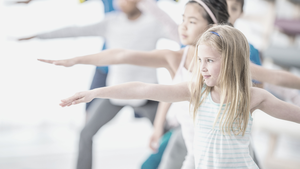 Young skaters practicing yoga Young skaters practicing yoga Whether you are focused on athletic achievement or life lessons, creating a safe space is crucial for the well-being of everyone involved. As a skater, I trained in environments that, from the outside, appeared healthy and safe. There was no physical or sexual abuse that I am aware of, and there was none of the heinous screaming and name-calling that still exists in many rinks. However, when I was younger, my coaches behaved like mean girls in club politics and created ugly rivalries where there should have been collegiality and friendship. Later, at a different facility, my peers had weekly weigh-ins, and I was applauded and revered for drastic weight loss that led me down a decades-long path of eating disorders. In yet another facility, I was made to feel like an imposter–just a “tester” among those actively competing. As a coach, I have always tried very hard not to repeat the mistakes of my teachers. Most of them were good-hearted with good intentions, even if they were often blinded by their own competitive nature and their own past wounds and teachings. So, without a good model in my background, I repeated some of the same mistakes. Pushed kids when they didn’t need to be pushed, compared skaters to one another when I shouldn’t have, offered dietary advice without being a licensed dietitian and tried to convince a skater to stay in the sport when what she really, really wanted was to be done. For many years I coached in an environment that closely followed Safesport guidelines. Yet, it didn’t feel healthy and was arguably quite harmful to me and many others. Playing favorites, forming cliques, ignoring skaters who need extra emotional support, and politicking amongst coaches are surefire ways to ruin a healthy, collegial environment. While Safesport and SkateSafe attempt to prevent and prosecute the most egregious acts of abuse in our sport, they fall short in many ways, especially in instances of emotional abuse. Their shortcomings are beyond the scope of the post, so I will simply say that I believe we need good models of conduct and spirit that go deeper than US Figure Skating’s Code of Conduct and the PSA’s professional standards.  A space for practicing yoga at home A space for practicing yoga at home As a figure skater, beginning a yoga practice–or starting to “do yoga” –can be overwhelming. There is so much information online it’s hard to know who to trust and where to look. Besides, society presents this image of yoga as bubbly young athletes sweating in Lululemon doing crazy poses. The franchise yoga business in many cities has perpetuated this myth. Sure, some yogis are very flexible, even hypermobile, but most of us aren’t. The reality is that all figure skaters already have some experience with the foundations of yoga, whether they know it or not. Spirals, catch spirals, lunges, Biellmanns, split jumps, layback spins, etc. Many of the movements and movement patterns we use in skating are very similar to those of yoga, as is the overall focus on balance, strength, and flexibility. In fact, I was drawn to yoga because when I practiced, it was the first time I felt like my body could move in a somewhat similar, yet more gentle, way than skating, and the first time ever I felt like I could synchronize my breath with my movement. And that was the most powerful tool I had ever experienced. The additional reality is that yoga has something to offer every single skater. In a post a few weeks ago I even talked about how the foundations of yoga - Patanjali’s 8 limbs - relate to the skating journey. In short, I broke down the foundational journey of yoga to show how it parallels some aspects of the figure skating journey:
So back to the original question… where does a skater go to begin “doing yoga”? |
Author // the skating yogiMy name is Sarah Neal. I have been immersed in the world of figure skating for over four decades. I have seen firsthand the abuse that happens at the higher levels of our sport and experienced how that trickles down into unhealthy training practices and habits at the grassroots. I have seen this play out in the operations of the very institutions that control our sport. Whether for a profession or hobby, pursuing skating should be a joyful, rewarding process, an opportunity for athletic and personal growth, and a place to build lasting friendships. Archives
October 2023
CategoriesAll Athlete Well Being Athlete Well-Being Deep Connections Embodied Movement And Meditation Practices Life After Competition Mindful Living |
Search by typing & pressing enter

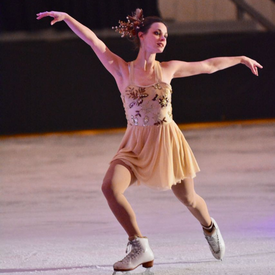
 RSS Feed
RSS Feed